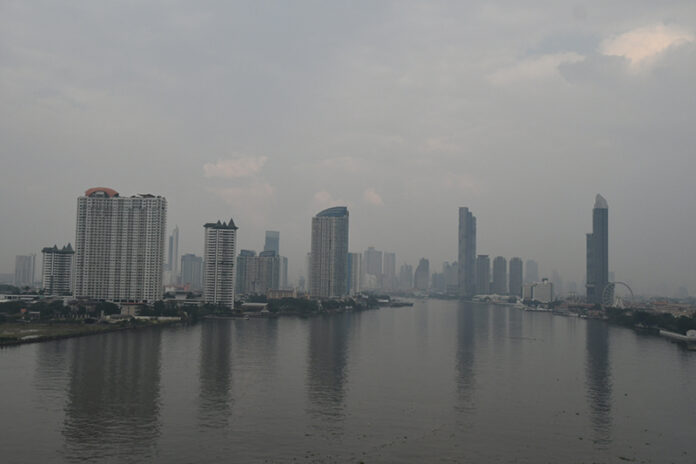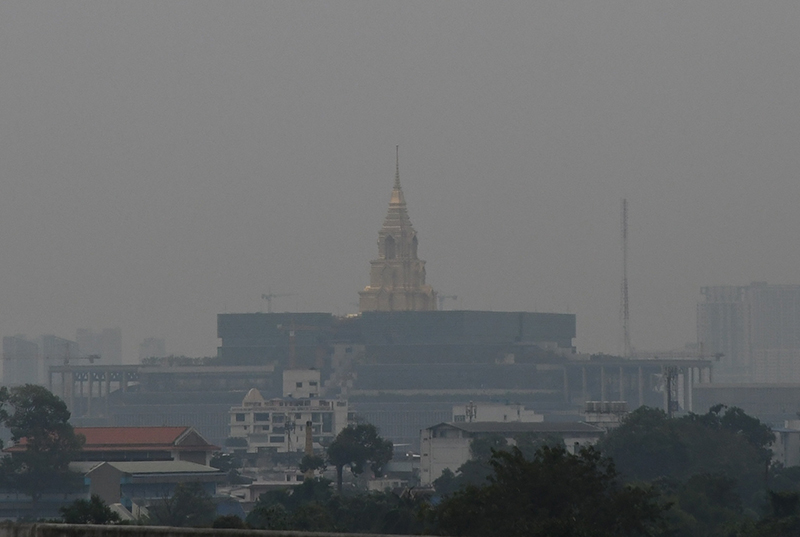
BANGKOK — Government officials on Tuesday promised a raft of measures to tackle the worsening air pollution in the capital – including enforcing a ban on open-air burning that’s virtually never enforced.
Density of PM 2.5 particles reached an “unhealthy” level in at least 14 districts of Greater Bangkok this morning, Pollution Control Department director Attapol Charoenchansa said in a news conference.
Unfavorable weather conditions were partly to blame for the toxic smog, Attapol said, but the government will also try to put an end to open-air burning of crops and trash in provinces close to Bangkok “until Thursday.” Checkpoints will be set up to catch vehicles emitting black smoke, especially diesel vehicles more than 15 years old.
“We will go to the next level in dealing with the problem. We will do even more checks,” Attapol said.
Attapol said that if the PM 2.5 situation does not improve, the government will consider extending the burning ban. Motorists with diesel cars should also refill their vehicles with low-sulfur petrol, the director said.
A Ban That’s Never a Ban
Experts say main sources of PM 2.5 smog in Bangkok are motor exhaust, industrial pollution, and dusts carried by winds from widespread burning of cash crops, such as corn and sugarcane, outside the city.
Open-air burning is illegal under a number of central and local legislations, including Article 220 of the Criminal Codes, which carries a maximum punishment of seven years in prison, but those laws are rarely enforced, an operator at the Pollution Control Department hotline said.
“For example, if someone burns their own field and no one files a complaint, then that’s it, it’s just left to burn,” she said. “But if a neighbor is inconvenienced by the burning, then they might file a complaint.”
Even then, fines and punishments are usually decided by the local municipalities, and cases are unlikely to go to court. Another officer at the Pollution Control Department said that some local officials simply allowed farmers in their jurisdictions to burn the crops without any penalty.

And when the authorities do put their foot down on the burning – goaded on by public outrage – their efforts are known to backfire. Soon after officials in Phrae announced a zero tolerance policy on open air burning in 2019, many put their fields to torch before the ban could come into effect, causing even more pollution.
The economic slump caused by the coronavirus pandemic also saw a number of industrial plants turning to cheaper and more polluting sources of fuel, like coal and other fossil fuels, said Greenpeace Thailand director Tara Buakamsri.
And since many factories do not have their own equipment to measure their PM 2.5 output, observers can only gauge the pollution levels through the amount of particles in the air.
“In Bangkok the dust levels fluctuate heavily. On some days, the sky is clear but on other days the dust is so heavy that close-range visibility is really bad,” Tara said by phone Tuesday. “That’s because the sources of the PM 2.5 dust didn’t lessen at all.”
City of Life?
No one knows how long the smog will last. Health officials on Tuesday warned Bangkok residents to wear masks at all times when staying out and avoid all outdoor activities, such as exercises, if possible.
Those with sensitive skin conditions could develop rashes, while breathing in excessive PM 2.5 can also irritate the nose and throat.
The Air4Thai website run by the Pollution Control Department lists all parts of Bangkok as the site of hazardous pollution that affects one’s health.
Air quality is especially bad in the central districts of Samphanthawong, Pathum Wan, Khlong San, Dusit, and Bang Phlat, as well as Bang Sue and Laksi in the north, and Nong Khaem and Bang Bon to the southwest.
IQ Air also registered high PM 2.5 levels in all of Bangkok, with the worst pollution recorded in Lat Phrao at 222 AQI, or “very unhealthy.”
Attapol, the pollution control director, said that deputy PM Prawit Wongsuwan has ordered all relevant departments to work together and tackle the PM 2.5 problems.
They include the City Hall, the police, and the interior, environment, transport, and public health ministries.

